

11-16 May 2022. If the historic core is Split’s venerable matriarch, then the waterfront pedestrian boulevard, known as the Riva, is Split’s beauty queen. And it’s the best place in the city for people watching.
But first a little people watching in and near the Old Town. . . . . at the public drinking fountain in Strossmayera Park: I am as delighted as the child with the Aquedukt Fontana.
In the window of a gallery in the Old Town this image of a sports woman entices us to enter as another rushes by.
Girls and ice cream.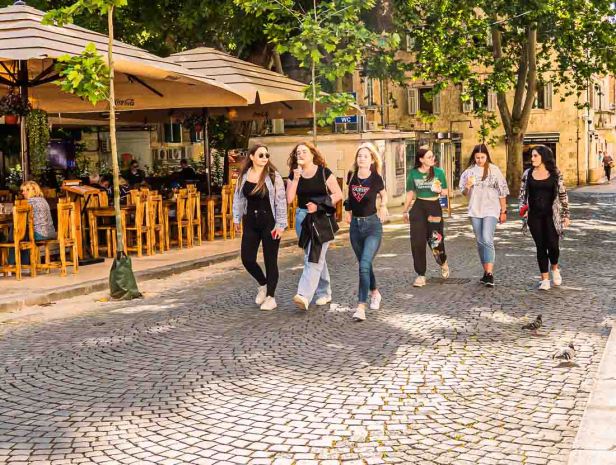
Pizza delivery by bicycle in the narrow Medieval streets.
In the ancient neighbourhood of Varoš this friendly woman smiles for the camera. She’s pegging out laundry through the window, as is the custom in these ancient places, and I catch her at it. Do note, though, that the windows and shutters are new. Despite its age of over four hundred years Varoš is a highly prized (and expensive) neighbourhood.
I’m attracted by colour, and I’m attracted by boldness and originality. I’m attracted by a kind of fearlessness that’s indicated by clothing that doesn’t follow the norm, that says something unique about the person wearing it; that says I love clothes and fashion and I’m not afraid to have my own style; or that says I don’t give a rat’s ass what others think, this is what works for me; or that simply says I haven’t a clue about fashion and I really don’t care.
Some people have their own inimitable style.


In Strossmayera Park, just north of the Old Town, on the day of a small festival for people with special needs, we chat with this lovely woman.
It’s her elegant style that attracts me, and the boldness of the necklace. She has a pop-up stall selling small paintings, fridge magnets, ceramic pendants. And little hand-made fabric flowers. In a gesture of spontaneous generosity she hands one to me and another to S. I always wonder where this kind of generosity comes from. I wish I had more of it. It has happened many many times during all my years of travel, this giving of small gifts from pure kind-heartedness, and, I imagine, the joy of connection. It always comes from the connection, an enthusiasm shown for a person or place, and the enthusiasm returned in kind. And it’s always a joyous, heart-opening moment. The camera connects me with people in the best way.
In Diocletian’s Palace, in amongst the ancient ruins that are the origin of Split’s Old Town, we come cross a photo-shoot. This is the producer, the designer, and the model.
This is the model, in a glittering silver frou frou, draped across the top of a Roman wall over 1700 years old, and behind her both Medieval and contemporary housing.
And this is the designer. I speak to her. I tell her how fabulous I think her outfit is. What a way to dress up a pair of ripped jeans and a white t-shirt. Style with a capital “S”!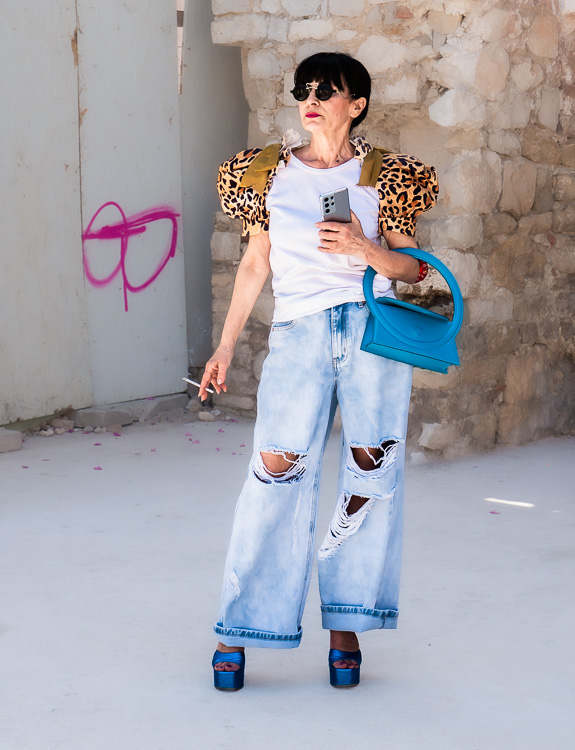
And now back to the Riva, Split’s magnificent waterfront, also style with a capital “S”.
It hasn’t always been like this.
When Diocletian had his palace built in the early 300’s the wall of the palace-fortress rose straight up from the water, an impenetrable grey stone barricade. By the time Napoleon was boss, about 200 years ago, it had begun to take on its current form as a waterfront promenade. Over the years it has been widened and restructured many times, but it has always been blessed with a fabulous setting, the ancient Roman and Renaissance buildings on one side, and the shimmering blue Adriatic Sea on the other.
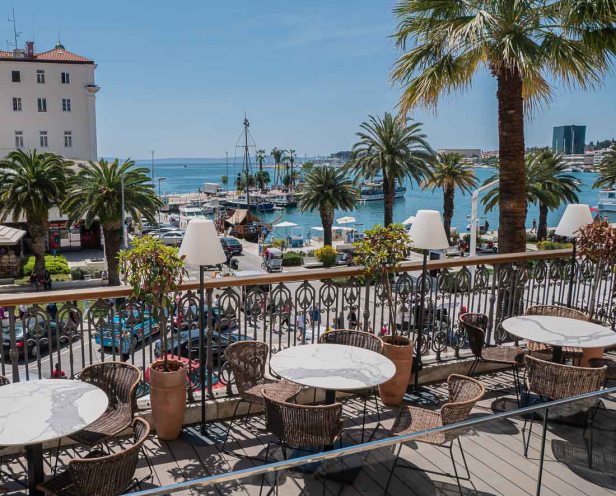

Then in 2005 the city held an international competition for the complete refurbishment and redevelopment of the waterfront. The competition was won by a Zagreb firm, 3LHD Architects, and the project was completed in 2007. Two hundred and fifty meters long and fifty-five meters wide, the Riva is where the city meets the sea. It is undoubtedly the most important public space in Split.
Considering its exceptionally valuable role in the city of Split, the competition guidelines for the waterfront restoration had very precise requirements for respecting cultural and historical heritage, taking particular care of the contact zone between the project area and Diocletian’s Palace, a world heritage site protected by UNESCO.
The project’s goal was not to simply add a new modern layer atop the earlier structure, but to free the existing surface of everything superfluous, establishing an infrastructure that meets the needs of contemporary life.
I love it for the spaciousness, for the bright open energy, for the azure sea, for the sense that this is Split’s place, for the people who live here despite tourist row.

And I love it for the people. We are there in the spring and it’s never crowded, but always busy, alive. So much coming and going, so many stories walking over the polished white concrete paving
that runs the length of the Old Town from the Port Authority Building at one end to the Franciscan monastery and St Francis Church at the other.
Everywhere there are interesting gatherings, and conversations, both relaxed,
and animated.
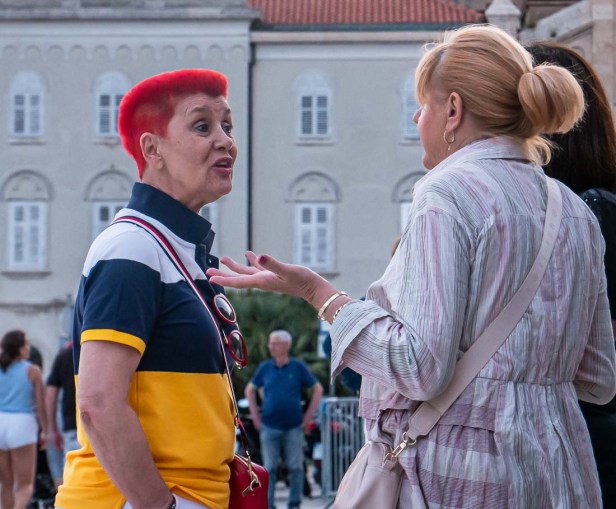
A football team from Germany.
A selfie for four.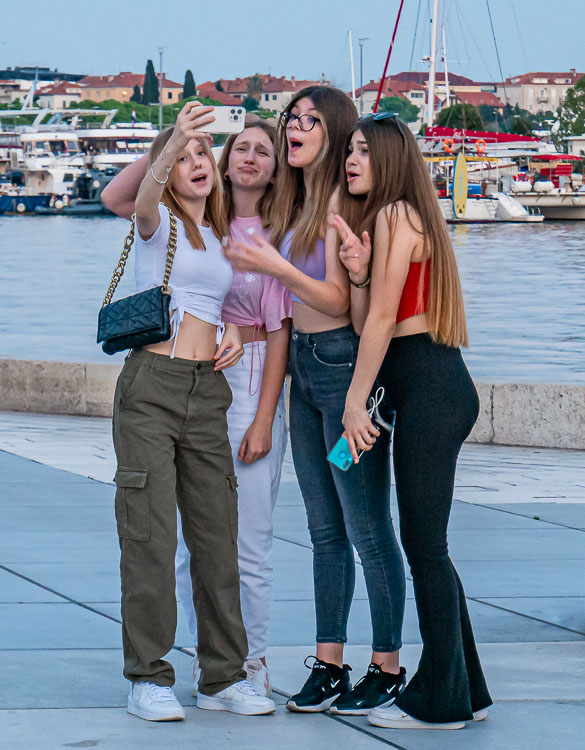
The sunset parade.



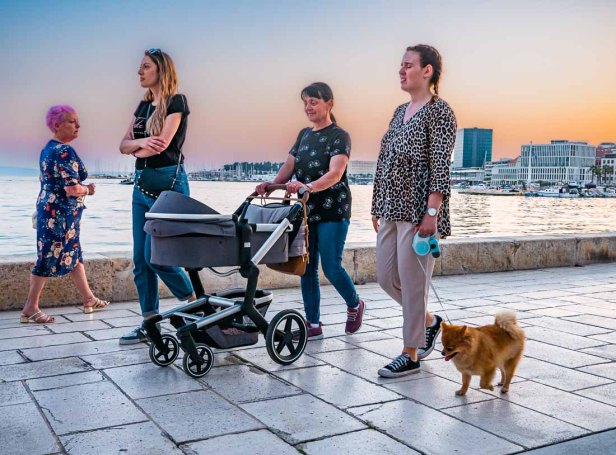
The Riva, the essential symbol of Split, is often described as the city’s living room with its cafés, bars and restaurants, its gardens and palm trees and benches. This pedestrian boulevard is such a bright attractive space that people are inevitably drawn to it.
Four times we leave and return to Split by ferry, and every time rejoice in seeing its beauty from the water.
We have dinner one night on tourist row. The meal’s okay, but a better form of nourishment is watching the full moon rising behind the steeple of St Francis Church,
and watching the comings and goings of the Jadrolinija Ferries, and the woman selling sparkly balloons
as the day comes to a satisfied end.
All the world’s a stage, and in Split the main stage is the Riva. It’s the stage for cultural and entertainment events, religious processions, celebrations, for political rallies and demonstrations, to see and be seen, and for tourists and locals to soak up the splendour of the city.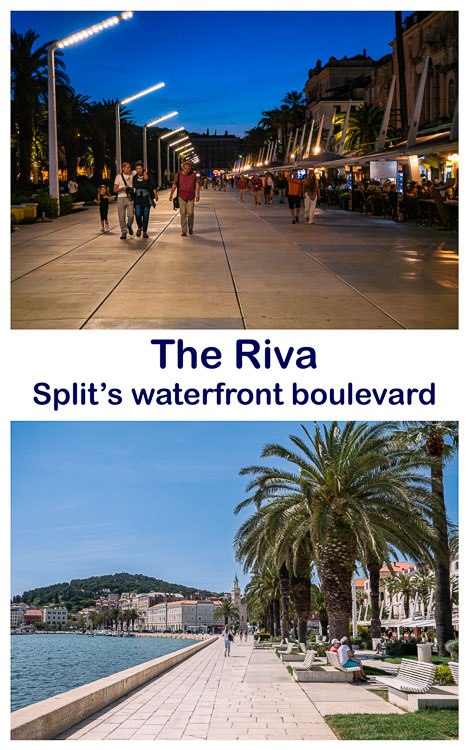
Next post: The island of Brac and Zlatni Rat Beach
All words and images by Alison Louise Armstrong unless otherwise noted
© Alison Louise Armstrong and Adventures in Wonderland – a pilgrimage of the heart, 2010-2022.

Fabulous photo story. I love the precocious little girl.
LikeLike
Thanks so much Darlene. The little girl is one of my favourite photos. I watched her for a while. Personality plus!
Alison
LikeLiked by 1 person
Split’s waterfront is stunning and so are ALL your photos. Love the fashion ones! Well done Ali, 💕Linda
LikeLiked by 1 person
Thank you so much Linda! 🤗
No surprise I love the fashion ones too 😂
Ali 💕
LikeLike
A fantastic photo diary, Alison! The weather was perfect for making photos 🙂
LikeLiked by 1 person
Thanks so much Len. There was so much there to entice a photographer. We were very lucky with the weather.
Alison
LikeLiked by 1 person
Alison, What a delightful series! Your street photography skills are excellent and you really capture interesting moments and poses. Split looks beautiful and vibrant. I’m sorry we didn’t go when we were in Dubrovnik.
LikeLiked by 1 person
Thank you so much Jane. I appreciate your kind words. Street photography can be a challenge for sure, but it’s my fave I think. People are so interesting! Split is quite lovely by the water, and really interesting in the Old Town. Perhaps you’ll get back there one day.
Alison
LikeLike
Your shots are fabulous, Alison! I love the casual and beautiful people shots, so natural!
LikeLiked by 1 person
Thank you so much Pat. I do like to catch people spontaneously for sure. Some photographers are truly great at creating posed shots, but most are not. Including me 😂 so I like the spontaneous natural ones best.
Alison
LikeLike
That opening shot is a real stunner! I always adore waterfront cities, and I love it when there is a mountain near a city. And Split has both! I wish there was an Indonesian city this pretty. As usual, you managed to capture some interesting shots of the locals — bright colors, an animated conversation, and just the overall relaxed ambiance of Riva.
LikeLiked by 1 person
Thanks so much Bama. Split is really beautiful with the Adriatic and the mountains. I’m glad we went there.
The Riva had such a relaxed feel, with all the people out and about, locals and tourists mixed. I loved that we were there in the spring so there were not that many tourists.
Alison
LikeLiked by 1 person
That looks like an amazing and fun place to be.
Excellent photos, Alison.
LikeLiked by 1 person
Thanks so much rabirius. We loved Split – definitely both amazing and fun.
Alison
LikeLike
I loved watching your photos on Facebook Alison. What an incredible trip you had! Beautiful as always.
LikeLiked by 1 person
Thanks so much Nicole. I’m glad you enjoyed the FB photos. It really was an incredible trip; not always easy, but so fabulous in so many ways.
Alison
LikeLike
I didn’t realize that the Riva waterfront was so newly constructed! Wonderful photos, you’ve captured it beautifully!
LikeLiked by 1 person
Thanks so much Mo. It was a bit of a photographers dream for sure. Much of Croatia was like that.
I had no idea the Riva was so new either! I saw some photos of it before redevelopment and it really needed it. The city made a good call deciding on the upgrade.
Alison
LikeLiked by 1 person
We really gave Split short shrift; you were smart to give it a little more time and to walk the streets in a leisurely way. The people shots are (as usual) fantastic!
LikeLiked by 1 person
Thanks so much Lexie. Always fun photographing people 😁
We did enjoyed Split, even though we were recovering still from food poisoning. Just because of that it was good to have the extra time.
Alison
LikeLiked by 1 person
Lovely people watching, as always. Sometimes it’s hard for me to choose a favorite picture from your posts. This time it was dead easy – the little girl with hands on hips in the sunset parade is priceless! 😀
LikeLiked by 1 person
Thanks so much Felicity. I too love that photo. My other top pick is the selfie for four – they’re all so darn cute!
Alison
LikeLike
But Split? Where in the world is it?
LikeLiked by 1 person
Oh sorry, I guess I don’t make that clear enough. All posts are by category and my categories are by country so it’s right at the top: Posted by Alison and Don in Croatia, Europe. But it’s small so I can see why you missed it 😟
I’ll rethink that – I imagine it would be helpful if I mentioned it in the post somewhere as well.
Thanks for reading, and commenting 🤗
Alison
LikeLike
We spent several days in Split about a decade ago. Your gorgeous photos bring back so may happy memories.
LikeLiked by 1 person
Thanks so much Sue. I imagine it was a bit different when you were there, but the Riva was redeveloped right? Glad I brought back some good memories!
Alison
LikeLiked by 1 person
Yes it was beautiful to walk along. Such a contrast of the historical buildings close by.
LikeLiked by 1 person
Great portraits! The conversation, the fashions, and the girl at the fountain all brought a smile.
LikeLiked by 1 person
Thank you so much. Happy to have brought a smile to your face. People are so interesting in all their activities and idiosyncracies!
Alison
LikeLiked by 1 person
You outdid yourself with the street shots of so many interesting people of all ages and predilections. I love the story about the well-dressed artist who gave you all paintings. And the light in the sunset parade photos is extraordinary. 🙂
LikeLiked by 1 person
Thanks so much Lynn. I had a lot of fun with street photography this time. My fave thing to do is find a good spot and just watch/photograph people as they go by – hence the sunset parade pics.
Alison
LikeLiked by 1 person
This might well be my favorite entry from your trip to Croatia so far – your photos and descriptions of the Riva practically made me sigh with delight! Especially now that I live in a city that lacks accessible, well-designed public spaces and parks (though things are gradually improving on that front).
The new(ish) design of the promenade strikes such a great balance – the place feels modern yet ancient at the same time, respectful of all that history on its doorstep. And you definitely picked the perfect opening shot… I did not know Split had such a beautiful backdrop of craggy mountains.
Plus your street photography is always so much fun. I really liked the shot of the smiling woman pegging out laundry, and that fashion designer exudes real confidence and elegance – her pose makes me wonder if she was previously a model herself!
LikeLiked by 1 person
Thanks James, I’m glad you enjoyed my street photography, and seeing Split’s Riva. Sighing with delight is appropriate – it’s such a delightful place. I think they did an excellent job with the refurbishment.
I do love to take pictures of the people wherever I am – always interesting! And yes, that designer may have been a model at one time. I loved her style.
Alison
LikeLiked by 1 person